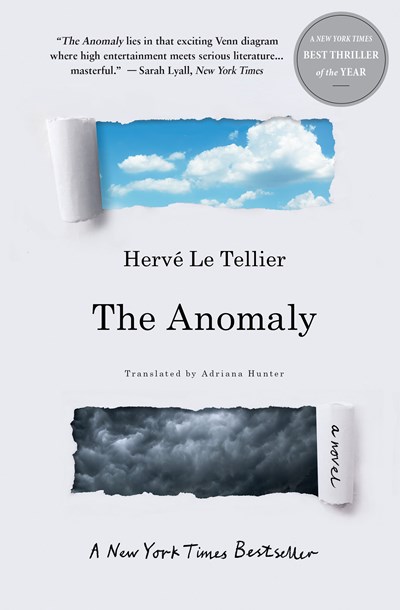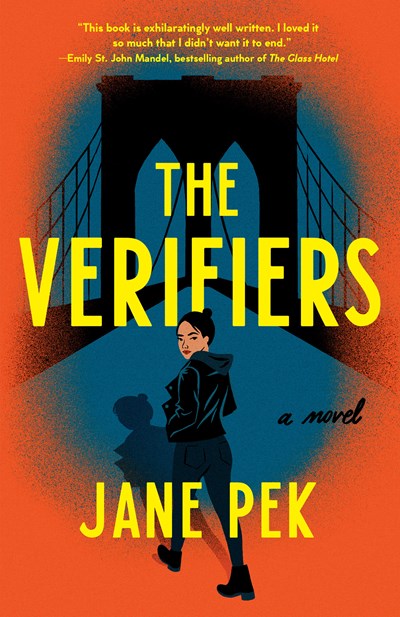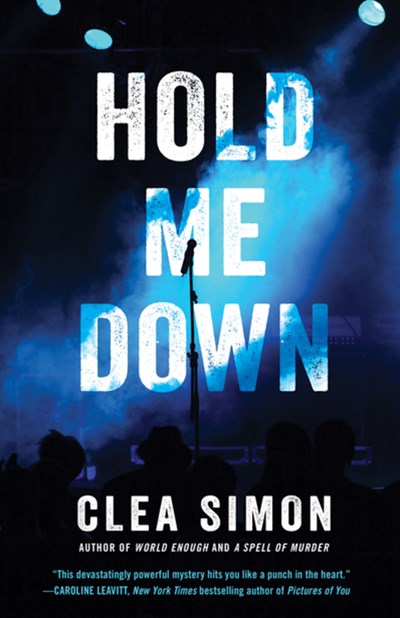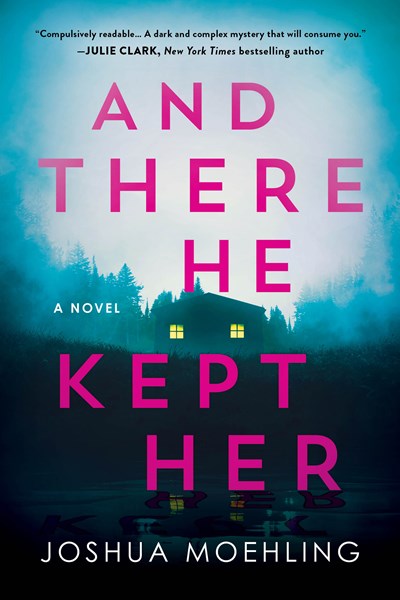Get ready to care far more than you thought you could about fictional strangers. The three in question are Jade, the busy, pampered wife of Atlanta celebrity chef Cam Lasky; and her children, Beatrix and Baxter. This book wastes no time on background, and we get to know these characters as they enter a domestic horror scene. Arriving home from violin-prodigy Beatrix’s music lesson, they are met in the garage by a masked gunman who takes them hostage for a day of psychological terror. He wants $734,296, an odd demand that Jade gives her flashy husband when she can get a word in over the phone, starting him on a desperate quest. The overextended, secretly broke businessman, who’s not the most sympathetic character, is brought to his knees while his family’s love and strength are pushed to the limit. Each character is meticulously drawn, and presented from multiple angles, as the story plays out from the alternating viewpoints of Jade, Cam, and for a short time, the kidnapper. In a clever device, much of Cam’s narrative involves him answering questions in a post-event sensationalist TV interview, which allows Belle (Dear Wife, The Marriage Lie) to parcel out information bit by tantalizing bit. Read something mellow after this, you’ll need it.
Review
Á la Anna Lee Huber’s Verity Kent and Stephanie Graves’ Olive Bright, Electra (Ellie) McDonnell has taken on a “man’s job” while much of the male workforce is away fighting World War II. Ellie is a heroine with a difference, though: she’s a former thief, from a London family that has called its safe-cracking ways to a halt. They’re now working as locksmiths and, in Ellie’s case, using those skills to aid the war effort. Ellie’s government handler, posh Major Ramsey, comes calling again in this second in the series (after A Peculiar Combination, 2021) when a young woman is found dead wearing an unusual, locked bracelet. Locksmithing again comes into play when a key turns up as part of the case, but it soon takes a back seat to Ellie’s other skills. This memorable, tough sleuth continues her investigation into the young woman’s death and her own mother’s long-ago imprisonment as the Blitz starts and a cousin at the warfront hasn’t been heard from. Happily, romance enters the picture, with Ellie pursued by both the major and a more down-to-earth family friend, Felix Lacey. The mysteries, danger, and emotional hills and valleys that are life in wartime will keep readers rapt here and wanting more from this almost-honest woman and her loving, protective circle.
One of the most fascinating detectives to have come along in years, Tully Jarsdel isn’t your typical cop. He abandoned a doctoral program to attend the police academy. He was raised by two dads, one of whom escaped Iran as a refugee. And he’s a brainiac—with so much trivial knowledge that his partner, detective Oscar Morales, calls him Rain Man. But he’s perfectly suited to investigate the death of Dean Burken, who was violently murdered in his own home. Burken, it turns out, was a registrar at The Huntington, a museum, library, and garden. Registrars can be powerful people, and Tully is quick to realize that Burken was abusing his position—in a big way. From deep inside The Huntington to Catalina Island, off the coast of Los Angeles, Tully and Jarsdel pursue a narrative of fraud, corruption, and greed. Fortunately, the detective work is offset with family issues, as one of Tully’s parents has a serious health crisis and the other struggles to deal with his past in the Iranian revolution. Throughout, Tully remains introspective, elusive, and unsettled—making the prospect of a fourth book all the more compelling.
Perhaps inspired by the real-life disappearance of Northern Ireland mother Jean McConville, Dempsey invites us inside two crimes. The first is a murderous attack on five roommates, and then there’s the cold case resurrected by the message scrawled on their wall: Who Took Eden Mulligan? Eden’s children, now adults, have been adamant in the decades since her disappearance that she wouldn’t leave them, but the woman was an enigmatic outsider in “a pit of savagery and subterfuge.” A Protestant living in a Catholic area of Belfast, she looked a mite too good for neighbors to care about her fate. Detective Danny Stowe has lots to lose in his inquiries—he’s on thin ice after smashing a perpetrator’s head against a wall and needs this win. For that, and more personal reasons, he persuades his best friend from college, a forensic psychologist who’s enduring her own issues, to join the investigation. The old and new cases, and the broken families involved, bring forth the weariness of living in sectarian strife, a mundanity that’s broken by moments of horror. Dempsey excels in portraying the anger that emerges when the dreamy veil of struggle lifts to reveal political violence as “a cover for psychopaths.” Read this for both a satisfying puzzle and an inside look at a culture turned sour.
When young Swedish woman Eleanor finds her manipulative, angry grandmother Vivianne dying of a stab wound, she’s more depressed and bewildered than sad. Vivianne raised Eleanor on a steady diet of scorching belittlement after the girl was left an orphan. Eleanor’s now working to overcome the hurt while learning to cope with prosopagnosia, or face blindness (she can’t recognize faces, even her own in the mirror). The story quickly moves to Solhöga, Vivianne’s country mansion, where Eleanor, her boyfriend and aunt, and Vivianne’s lawyer aim to inventory the contents. The chore becomes a terrifying ordeal when various members of the party come to mysterious harm; the somber house and sad diary entries detailing the lonely days of a long-ago maid at Solhöga add to the forbidding atmosphere. Sten’s character-driven, psychologically immersive puzzle will keep readers guessing until the end about who killed Vivianne and what’s behind the mysteries at the house. Eleanor’s face blindness adds an interesting and thankfully not overused element to the tale; an apt complement to this is Sarah Strohmeyer’s Do I Know You? (Harper, November), which features a “super-recognizer” who remembers for years the faces of people she sees even once in a crowd.
As well as offering a peculiar and captivating story, this winner of France’s Prix Goncourt prize, for the “”best and most imaginative prose work of the year,” stands out as wonderfully French. Le Tellier describes his characters in gutting detail while maintaining a distant nonchalance, inviting readers to share in his weariness at how emotionally finished these people are. Among them is Victor Meisel, who resembles “a healthy Kafka who made it past forty” and is writing a book called The Anomaly; André, an architect who’s desperate to hold onto the love of his much-younger girlfriend, and Lucie, that girlfriend, who’s drifting away; David, who’s facing a deadly illness; and Slimboy, a famous singer who spends all his energy maintaining the facade that he’s straight. Their shredded emotions are on display in the lead up to a Paris-New York trip, with each then depicted as one of a handful of strangers on, and the pilot of, a flight that experiences near-lethal turbulence with a bizarre aftermath. Emotions are just one of the problems faced by the survivors, who find themselves captive in a situation that involves not only the CIA and FBI but even the President of the United States (“a fat grouper with a blond wig”). Viewers of Netflix’s hit series Manifest will recognize some elements of this story, but the book and the show are unrelated and the aftermath of the flight is different enough to enthrall fans of the show and to keep them reading to the end.
Ten years ago, Lydia was kidnapped, then spent the subsequent decade locked in a hunting cabin, subjected to torture and abuse. Miraculously, she managed to escape—feigning death—and after several months of homelessness made it to the coastal town where her husband, Luca, and Merritt, his second wife, live. At first glance, Luca and Merritt, who married a couple of years after Lydia disappeared and was declared dead, have it all: homes, cars, several restaurants that they own, a beautiful child, another on its way. How will Lydia’s resurrection rock Luca and Merritt’s world? With chapters alternating between Lydia and Merritt’s points of view, we watch the tentative relationship between the two women grow. Merritt tries to help Lydia while Lydia charts her own course, deciding how she wants to be helped. Kent does a terrific job of creating suspense—we know a bomb is about to go off, just not which one—and when it does, we’re totally spun about. But the book doesn’t end there, as two more revelations upturn everything we know. Credible? You’ll be too terrified to care.
Heads up! A smart, witty amateur detective has entered the crime fiction galaxy, and you won’t want to miss her. Twenty-five-year-old Claudia Lin, from a Taiwanese-American family, doesn’t live up to anyone’s model-minority expectations. She visits her mother in Queens monthly (not weekly), dates girls (not nice Chinese boys), and has a job (not a career). But her position at Veracity, a sort of detective agency that can suss out the truthfulness of one’s online dates, turns out to be tailor made for her. So much so that when Iris, one of her clients, suddenly disappears, Caroline falls down the rabbit hole in pursuit of her, unearthing shocking information both about online dating companies and the fate of Iris. While solving the mystery is central to the novel, Claudia’s complicated relationships with her mom, Harvard-educated brother, and beautiful, vain sister provide wonderful distractions. For readers who enjoy quirky characters, strong female leads, and love/hate family relationships.
Simon, prolific author of the Witch Cats of Cambridge series, here mines her past as a rock critic. The tale looks at former rockers visiting their own past when they reunite for a benefit after former bandmate Aimee dies. During the concert, Gal Raver, frontwoman of the band and of the book, sees a familiar face in the crowd. It’s TK, the band’s old roadie, who’s later found dead in an alleyway behind the club. Walter, Aimee’s husband, is charged with murdering TK and seems curiously apathetic when Gal tries to help him fight the accusation. Finding out what happened involves numerous murky flashbacks to Gal’s past as a messy, angry drug and alcohol addict, and her behavior and the battle for fleeting success give the book a feeling of darkness. Simon’s evocative writing puts readers inside sweaty clubs that stink of beer and vomit (so much vomit!), and reaches its first height when describing the moment the fledgling band finally gels onstage. The music fades in the last part of the novel, which explores hard truths and the differing ways they can be remembered, with Simon’s depiction of Gal’s slowly unfurling memories a second high point. Note that rape is described here in some detail. For readers who enjoy dark stories and fans of music-themed mysteries.
Here’s the premise: two teens, a boy and a girl, break into Emmett Burr’s house in search of opiates. The house is remote, set on Sandy Lake in northern Minnesota, and the kids just assume that Emmett, old and immensely obese, will be passed out. But everything that can go wrong, does go wrong. Emmett shoots and kills the boy, while the girl, Jenny, is chained and left in a cell in the basement. It’s clear that she’s just the latest in a series of girls who’ve been locked up, abused, and eventually murdered. Fortunately, Jenny’s mother is quick to notice that her daughter is missing; she calls Sheriff’s Deputy Ben Packard, and the search is on. Ben, who recently moved from Minneapolis, spent his childhood summers on the lake; in fact, he’s related to Jenny. Packard’s search takes him to the dark underbelly of Sandy Lake, where alcoholism and drug abuse and violence and crime rule. Low-key Packard, who has his own secrets—he’s gay and just inching out of the closet—is as compelling and potentially as complex a cop as Louise Penny’s Armand Gamache. This is a remarkable debut—sharp, suspenseful, and emotionally powerful—sure to appeal to readers of Karin Slaughter and Lisa Gardner.










